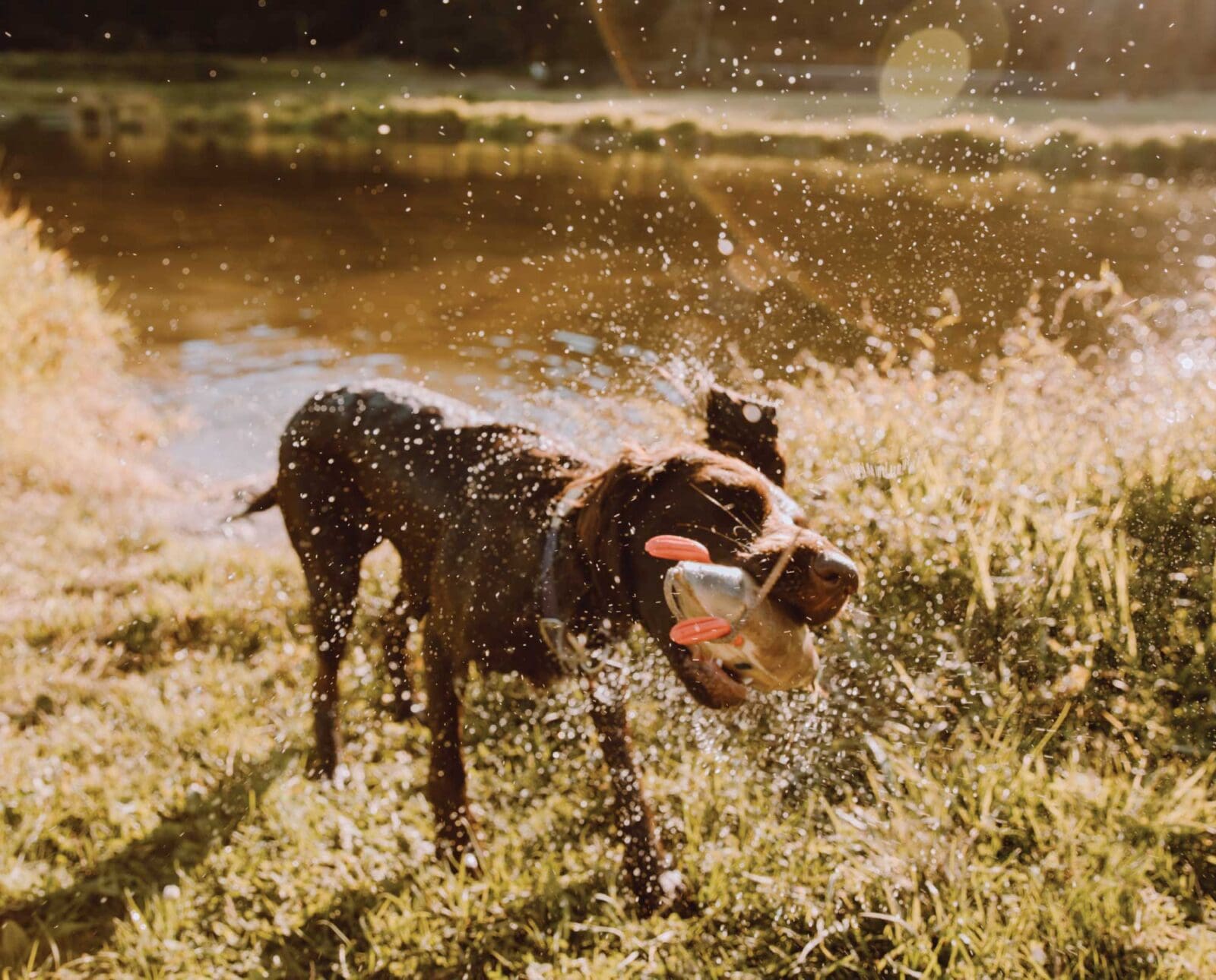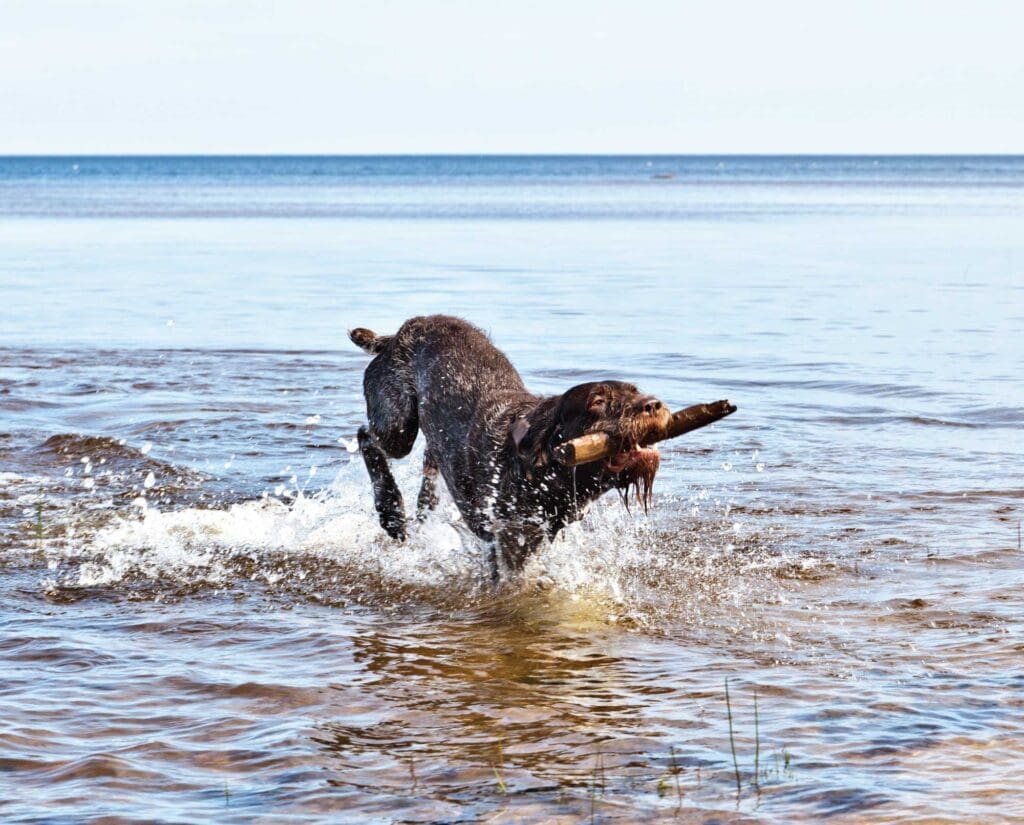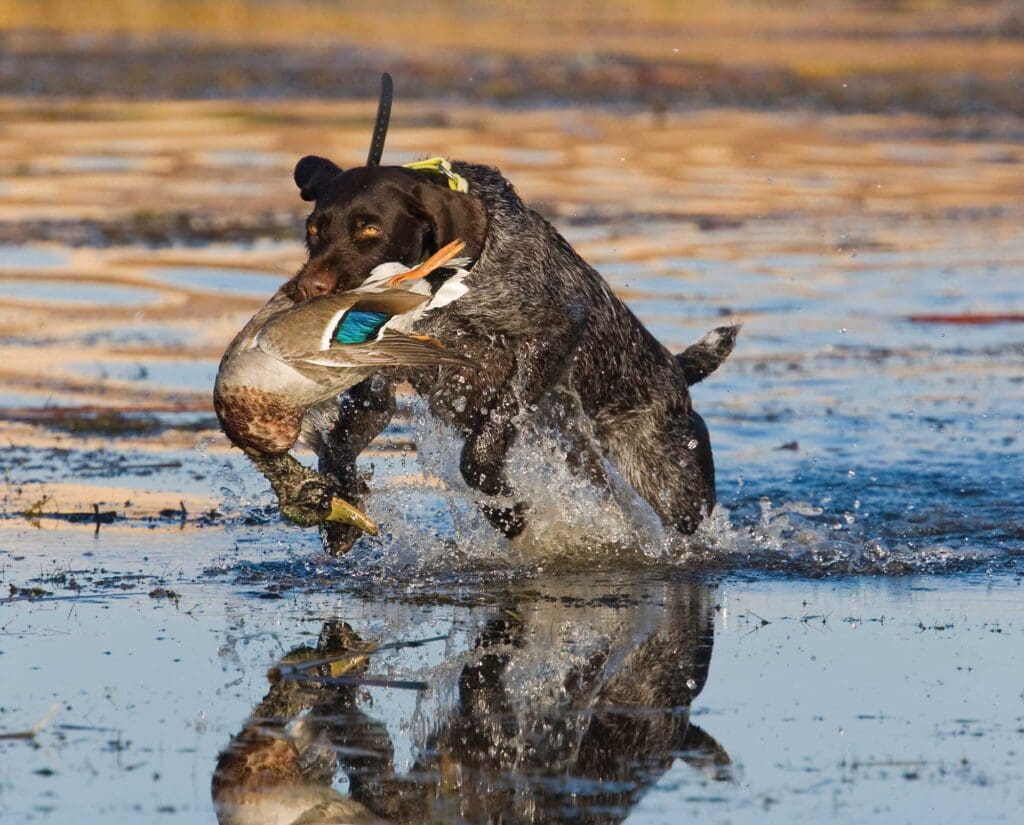Home » Hunting Dogs » How to Introduce a Dog to Water Work
How to Introduce a Dog to Water Work

Jason Carter is a NAVHDA judge, NADKC member, director of…
Keep these tips and ideas in mind when introducing your dog to water training
Sweat beaded on the handler’s forehead as I gave my instructions on the water. A cloud of nervous energy consumed him in anticipation of the day’s last event. After all, a prize one score was on the line. His young Brittany gave a stellar performance in both the field work and tracking portions of its test. Now, the pup excitedly pulled at the end of the lead, giving the handler a glimmer of hope that it would swim.
Listen to more articles on Apple | Google | Spotify | Audible
The NAVHDA Natural Ability test requires a young puppy to swim twice to show its affinity for water. It quickly became apparent this would be a challenge for this pair. The water’s edge was thick with black mud and decaying leaves, and it gradually got deeper.
After my instructions, the handler splashed wildly in the mud while encouraging the pup in falsetto tones, desperately trying to get the dog into chase mode. We all skeptically prayed for the best as the pup, and its handler darkened themselves with pond debris. We were awed by the commitment and sheer athleticism in their movements as they both somehow remained on their feet during the mud dance.
The handler dropped into a low stance and twirled in consecutive circles. The puppy’s eyes lit up. He began to chomp at the end of the bumper eagerly. Faster, faster they turned, but the bumper was not being thrown.
“Throw the bumper!” I pleaded. However, he apparently had a plan and continued to spin, but now with a bit of a wobble. Again, I begged, “Throw the bumper!” Unfortunately, he was at a point of no return. The bumper slipped from his fingers. The once-athletic maneuvers had turned towards what I could only describe as an out-of-control spinning starfish.
With one leg straight out, the handler crashed face-down into the mud. The handler rose from the muck to see his pup swimming for the bumper. Concerned for him, I asked him if he was okay.
“Okay?” he questioned. “I’m more than okay! That’s my pup’s first swim!” He wiped the mud from his grinning face. He called his pup back, and, to our amazement, he went straight back into twirling about the mud like a gleeful toddler. The crowd of friends and chapter members cheered as the pup made its second swim, elated by the team’s effort and success. It was obvious to everyone that this would be a turning point for the pup and its love for the water. It was an unforgettable day for both the young dog and its handler.
We all were excited to read him his prize one score. Our tradition for the prize one recipient is to provide the iconic Gatorade bath with water. However, since he was already soaked, we thought it was best to hand off a bucket of soapy water to help clean him up. Cheers and laughter erupted amongst the NAVHDA chapter. A weekend highlight for all of us and a memory we’ll never forget.
Water is Connected to Either Pleasure or Fear
Summer provides us with many sunny opportunities to relax and play. It’s also a great time of year to introduce a young dog to the joys of water work. When I reflect on that handler and his Brittany, I wonder how his introductions to the water went earlier in the pup’s development. Had there been much water exposure? Was it done properly? Handlers must understand that we can connect water to either pleasure or fear.
Without proper introductions, a puppy initially does not understand what water is. It believes it is something it can run on. The pup’s temperament dictates the experience when it falls into the water. Was it overwhelmingly negative, which might set you back in your dog training? Or was it overwhelmingly positive?
From day one, we develop a relationship of trust with our pup. The last thing we ever want is to betray that bond and delay its development. A successful swim is a culmination of many prior positive experiences while bonding. Many folks carry their pup into the water, letting it swim back or dragging it out by its lead. Again, depending on the nervousness of the pup, this could lead to a negative experience. Some throw their dog into the water out of frustration or ignorance, which is the worst experience possible for your pup. Using enjoyable tangibles like food, toys, or games to build drive are great incentives to make the water fun and encourage the pup to overcome its fears.

A pup can be encouraged to swim using what drives them. Once they get over the initial shock of their feet leaving the ground, puppies become more and more comfortable in the water. The challenge is getting the pup to decide to swim on its own. This requires us to build drive through positive associations and plenty of patience. Here are a few ways I use drive to develop a love for the water.
Using Food Drive When Training in the Water
Water development depends on various high-drive activities that help encourage a pup to overcome its insecurities. One of these activities is food drive. Food drive is built using edible rewards, which help us shape behaviors for our young pups. Trainers use food drive during training, and we reward pups with the highest-valued treats when teaching the most difficult skills, like swimming.
My go-to treat is a cheese puff when encouraging a love for water. They are bright, stinky, floaty, and puppies love them dearly. Initially, it’s just a few cheese puffs in a kiddie pool. Puddles and kiddie pools are my introductory water sources. Once the pup becomes comfortable, which usually takes a few weeks, I introduce new puddles, shallow brooks, and small ponds. I begin these introductions by tossing the puffs close to shore. Then, I slowly work my way out. After the pup acclimates to new waters, I move the treats away from the shore and towards swimmable depths, depending on the pup’s comfort levels.
Using Toy Drive to Encourage a Love for Water
Toy drive is using toys to encourage behaviors in dogs. It’s built through the use of enjoyable items such as pet toys, paint rollers, and bumpers. We encourage the puppy to grab, carry, and even come to us with its favorite toys by playing and chasing with these types of toys. Be sure to encourage your dog to really love bumpers with lots of low-pressure activities.
Avoid using tug and squeaky toys to build toy drive because they encourage hard mouthing. Having a hard mouth is a big issue when retrieving birds. Dogs with hard mouths crunch game to the point that it’s no longer fit to eat. Tug-of-war games and squeaky toys reward pups for aggressively chewing and chomping, which can carry over to retrieving birds later on. However, when retrieving toys are used properly and play behavior is driven high enough, you can develop positive experiences on the water and encourage your dog to swim. You’ll use the same process of starting with puddles or a kiddie pool and progressing incrementally to deep water.

Using Prey Drive and Pack Drive to Encourage Water Love
Using game birds in the water is the most influential and exciting way to get a pup to swim. When the pup’s prey drive is triggered, it will be encouraged to take higher risks. Game is great to use initially, however, we will need the dog to love bumpers. You’ll use various bumpers and training dummies to teach future water drills. We want to avoid making game-dependent swimmers.
As a puppy’s love for retrieving and chasing bumpers grows, I may use other dogs that swim to encourage the pup to follow or compete. This is called using pack drive. Some pups will simply follow the other dogs into the water, whereas others may require a frenzy of dogs chasing a tethered duck. The competitive nature of the pup will encourage it to swim. It’s important to be cautious not to use older dogs that could hurt or run over the pup when using pack drive; it’s best to keep similar-aged pups together for this approach. I will also walk out into the water myself and encourage the pup to come to me for praise and support.
Be Patient and Let Your Dog’s Water Love Evolve Naturally
When a puppy first starts swimming, it’ll look like a splashing motor. The front legs reach out of the water, its head is high, and the back legs are trying to touch the bottom. Eventually, the pup learns to plane itself out, which usually happens in conjunction with retrieving. Soon, the swim matures, and the pup becomes comfortable on the water. Once this happens, I change locations. I start acclimating pups to various entries, such as steep banks and drop-offs. It’s also important to vary the types of bottoms like sand, rocks, or mud, providing pups with plenty of exposure to be comfortable around all water.
During training, we teach pups how to get the things it enjoys in life: by following our lead. Through reading the attitude of our pup around water, we decide when and how we make the next introduction. We introduce the water only when we have developed a high-drive working relationship with our pup. Every trainer hopes that a pup will decide to learn to swim and become comfortable in the water on its own. Through making its own decisions, the pup won’t connect its concerns to you or its retrieving. Forcing pups to swim is when they become hesitant, which may encourage them to avoid swimming altogether.
Though there may be times you feel like making it swim, let your pup evolve naturally. Stick with the water training, keep things fun, and your pup will get there. A positive approach and association with going from land to water makes all the difference. With enough time and experience, your pup will launch itself into the water to get that retrieve. That being said, this obviously requires many sunny hours hanging out by the water’s edge, toes in the sand, and a choice beverage in hand, a sacrifice we must all make as trainers.
Jason Carter is a NAVHDA judge, NADKC member, director of youth development, secretary of NAVHDA’s youth committee, clinic leader and trainer at Merrymeeting Kennels. He has been around versatile hunting dogs his entire life, literally! Born into the Carter family and Merrymeeting Kennels, he attended his first NAVHDA test in Bowdoinham, Maine, when he was just a year of age. Jason successfully trains, tests and breeds Deutsch Kurzhaars in both the NAVHDA and NADKC testing systems. Through his work at the kennel, Jason has had the opportunity to develop pointers, flushers and retrievers over the years. When October arrives he can be found with family and friends hunting throughout New England.



